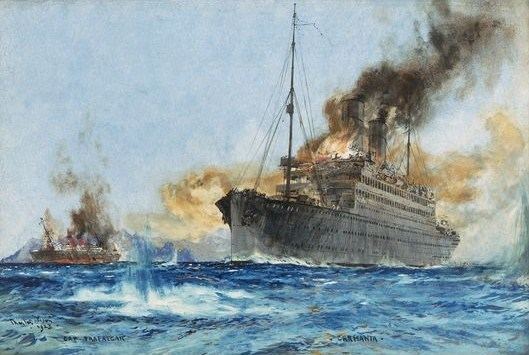 | ||
The following is a list, by period and country, of armed merchant ships used since late 19th century in the role of auxiliary cruisers, also called armed merchant cruisers.
Contents
Russian merchant cruisers
Note: This listing is incomplete.
Allied merchant cruisers
Spanish Civil War
The Spanish Nationalists, whose navy was substantially outnumbered by the Republicans, made an extensive use of auxiliary cruisers during the Spanish civil war, two of them on loan from Italy:
Allied merchant cruisers
The Armed merchant cruisers were made by requisitioning large ships and providing them with guns and other equipment. They ranged from 6,000–22,000 long tons (6,100–22,400 t). The armament varied but six 6 in (150 mm) guns with 3 in (76 mm) guns as secondary was usual. From 1941, many served as troopships.
French auxiliary cruisers were armed with 138 mm, 152 mm or 150 mm guns, 75 mm and 37 mm AA guns and 13.2 mm or 8 mm AA HMG
German auxiliary cruiser raiders
At the outbreak of war, the Kriegsmarine requisitioned a number of fast merchantmen and immediately sent them into naval shipyards to be converted into offensive auxiliary cruisers. These ships had at the time of building been fitted with extra strong decks specifically to facilitate the installation of military equipment when required, but this was the only difference between them and other merchantmen of the period. No precise plans had been drawn up for the conversion of these ships into warships, and consequently the conversion process was painfully long. Compared to the diversity of British auxiliary cruisers, the Hilfskreuzer were standardized insofar as possible. The ships themselves averaged approximately 7,000 long tons (7,100 t). Armament usually consisted of six 6 in guns, two to six torpedo tubes, and an assortment of 40 mm (1.57 in), 37 mm, and 20 mm (0.79 in) automatic weapons. Most of these merchant raiders carried an Arado Ar 196 floatplane for reconnaissance. Kormoran, Komet, and Michel were also equipped with small motor torpedo boats. In addition to armament, increased fuel, water, and coal storage had to be provided for as well. Furthermore, the raiders could not abandon the crews of their captures, so space had to be provided for prisoners. The first Hilfskreuzer got under way in March 1940, shortly before the Norwegian campaign.
Japanese armed merchant cruisers
Japan converted fourteen merchant ships to "armed merchant cruisers" but, by the end of 1943, five had been sunk and seven had been converted back to merchant ships.
Italian armed merchant cruisers
Unlike the Germans and the Japanese, none of the armed merchant cruisers (or auxiliary cruisers) of the Italian Royal Navy (Regia Marina) were deployed to destroy or capture Allied merchant ships. All of them mounted two 4.7 in (120 mm) guns.
